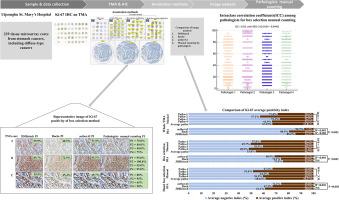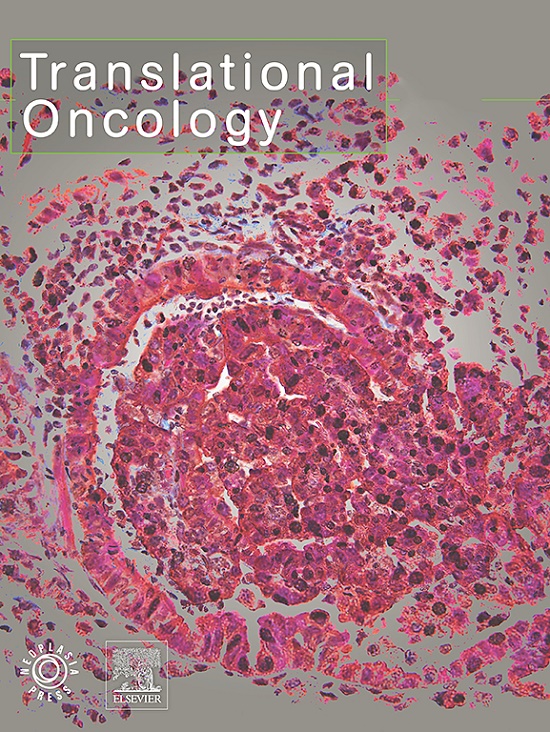Comparative analysis of Ki-67 labeling index morphometry using deep learning, conventional image analysis, and manual counting
IF 5
2区 医学
Q2 Medicine
引用次数: 0
Abstract
The Ki-67 labeling index is essential for predicting the prognosis of breast cancer and for diagnosing neuroendocrine and gastrointestinal stromal tumors. However, current manual counting and digital image analysis (DIA)-based methods are limited in terms of accurate estimation. This study aimed to assess and compare the capabilities of different DIA systems for Ki-67 counting using the conventional manual counting method. A total of 239 tissue microarray cores from patients with stomach cancer were immunohistochemically stained for Ki-67 and digitally scanned. For the analysis, we employed three different annotation methods: whole TMA core, box selection of the epithelium, and hand-free selection of the epithelium. We used DIA system of 3DHistech, Roche, aetherAI, and manual counting by the pathologists. The annotation methods showed different Ki-67 positivity but were lower than the pathologist manual counting. The results demonstrate that the Roche system is the preferred method for analyzing the entire TMA, whereas aetherAI outperforms the box selection method. Furthermore, 3DHistech is the most accurate method for hands-free selection of the epithelium. The manual counting results showed good agreement among pathologists, with an average intraclass correlation coefficient of 0.93. These results emphasize the importance of carefully selecting annotation methods to determine Ki-67 positivity. To determine the most suitable method for individual laboratories, multiple approaches should be assessed before implementing a DIA system in routine practice.

利用深度学习、传统图像分析和人工计数对 Ki-67 标记指数形态学进行比较分析。
Ki-67标记指数对于预测乳腺癌的预后以及诊断神经内分泌肿瘤和胃肠道间质瘤至关重要。然而,目前基于人工计数和数字图像分析(DIA)的方法在准确估计方面存在局限性。本研究旨在评估和比较不同 DIA 系统使用传统人工计数法进行 Ki-67 计数的能力。我们对胃癌患者的 239 个组织微阵列核芯进行了 Ki-67 免疫组化染色和数字扫描。在分析中,我们采用了三种不同的标注方法:整个 TMA 核心、上皮细胞的框选和上皮细胞的免手动选择。我们使用了罗氏公司的 3DHistech DIA 系统、etherAI 以及病理学家的手动计数。这些注释方法显示了不同的Ki-67阳性率,但均低于病理学家的人工计数。结果表明,罗氏系统是分析整个 TMA 的首选方法,而 aetherAI 则优于方框选择法。此外,3DHistech 是免手选择上皮细胞的最准确方法。病理学家之间的手动计数结果显示出良好的一致性,平均类内相关系数为 0.93。这些结果强调了谨慎选择标注方法以确定 Ki-67 阳性的重要性。为了确定最适合各个实验室的方法,在常规实践中使用 DIA 系统之前,应该对多种方法进行评估。
本文章由计算机程序翻译,如有差异,请以英文原文为准。
求助全文
约1分钟内获得全文
求助全文
来源期刊

Translational Oncology
ONCOLOGY-
CiteScore
8.40
自引率
2.00%
发文量
314
审稿时长
54 days
期刊介绍:
Translational Oncology publishes the results of novel research investigations which bridge the laboratory and clinical settings including risk assessment, cellular and molecular characterization, prevention, detection, diagnosis and treatment of human cancers with the overall goal of improving the clinical care of oncology patients. Translational Oncology will publish laboratory studies of novel therapeutic interventions as well as clinical trials which evaluate new treatment paradigms for cancer. Peer reviewed manuscript types include Original Reports, Reviews and Editorials.
 求助内容:
求助内容: 应助结果提醒方式:
应助结果提醒方式:


